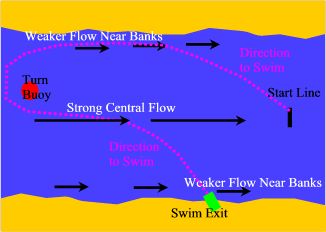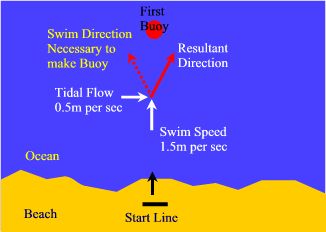Triathlon Swimming
As coaches we often ask our athletes about their weaknesses and by far the most common answer is "Swimming", which I don't find particularly surprising. Of all the 3 disciplines in triathlon swimming is the least natural for a human being, after all we naturally move fast using our legs and even if we aren't built with wheels we do go in cars, trains and busses from a young age, all with wheels and all traveling pretty swiftly.
This problem is further exacerbated by the following 2 widely held beliefs:
- Most people are intelligent and are convinced that if they immerse their heads in water they won't be able to breathe.
- In most sports to move faster all you have to do is move your limbs faster - this isn't necessarily true in the water.
The first of these is undoubtedly true and leads, in my opinion, to the majority of stroke faults in adults trying to accept a swim challenge in later life, when they haven't done so when younger. The second is untrue, in almost all situations, but particularly for swimmers.
To get the best out of your triathlon experience concentrating on the technical elements of swimming is exceptionally important. Moving through a substance that's 1500 times thicker than air, in a prone position and using your weaker muscles as the major propulsive force means that any flaw in technique immediately results in a slower performance and - even worse - a much greater waste of energy.
The video on the right illustrates some of the basic errors swimmers coming to triathlon often make.
Open Water Swim Video Help
This selection of videos show some excellent techniques to use when you swim in open water. From sighting to drafting and strategies, you'll find techniques to copy that will improve your open water swimming and racing experiences.
Open Water Training
Even more importantly, you will also learn how to train in open water. A good session is not simply swimming round and round in loops.Open water swimming brings with it a need for additional skills;
Wet Suit Swimming
If you are not the best swimmer then it's likely that a wet suit will improve your triathlon. The added buoyancy improves your body position in the water, decreasing drag, so better swimmers lose some of their advantage. However, swimming in a wet suit still has its problems. To work properly they have to be quite tight, so often when you first begin to use them, you feel like you can't breathe as freely as normal because of the restriction it places on the chest. Don't let this panic you, it will soon feel better.
This restriction can also affect the mobility of your shoulders and arms, making your stroke much flatter. More expensive wet suits are generally more flexible but if you find that your movement is more limited don't fight it. Instead use shoulder and hip rotation (up to 90°) to aid your recovery arm and your breathing.
The next problem you're likely to experience is getting out of your suit. You need to make sure you cut the legs and arms up sufficiently to get them over your feet and hands, so do this before your race. Next, as you prepare to exit the water pull the neck away from your body and let water fill the suit. Immediately you get out of the water pull the zip down and remove your arms before you take off your goggles & hat. When you get to your place in transition push the legs down as far as you can and then stand on one leg of the suit to and pull the other leg up and then shift your position and do it again to get it over your feet.
Swimming in Packs
The initial and most difficult problem that novice open water swimmers experience is the "Rough-and-Tumble" of open water swimming. Unlike pool based races there are no lane dividers and in a mass start everyone fights for their position. People will be fully prepared to swim over you if you're in front of them but swimming slower, so pick your initial position to be at the front, middle or sides or even at the back if you're a novice.
It's also where you get a little bit of gamesmanship, designed to make it difficult for you to swim your best race. Although this doesn't normally happen in the age group section of a race,
in the Elites it's not unheard of for a wet suit to be unzipped or someone to be pulled back pretty forcibly by the arm or leg. Pack swimming does have it's benefits. After the initial starting rush has ended races normally settle down to aerobic pace and there is a very good drafting effect from the swimmers around you. Just like in cycling if you swim very close to or just by the side of a slightly faster swimmer, they will drag you along at their pace, but while making your normal effort. Take advantage of this effect, it will save you time and effort, so practice it if you can.
Navigating and Tidal Flows
Without lane ropes, a center line down the pool floor and clean clear water you can see through, getting from one point to another in a straight line becomes much more difficult.


So you have to develop a method of looking where you're going and ensuring you're following the right course. Most people initially make the mistake of looking when they want to take a breath, so they raise their body out of the water right up to the chest. This has the immediate effect of slowing you down, you push down on the water instead of maintaining forward momentum. It is better to aim to make sure you maintain forward momentum by accelerating your stroking arm backwards slightly faster than normal and simply "Look Up" so your head is only out of the water to your chin, similar to a single arm of the butterfly stroke. The swimmer above illustrates the correct extent of head raise very well. It's best to sight like this every 4 to 6 strokes.
Remember too that you can't necessarily see through the water. At first this can be fairly disconcerting, especially if you're used to being able to see the bottom and the sides of a pool. You know that safety is only a short distance away because you can see it and when you can't it can instill a little panic. Again, practice is the key to getting used to these conditions.
Sighting
However, before you can find your way you need to know where to aim for. So prior to getting in the water look at the course and note the markers you should be aiming for. Large highly visible buoys are the standard for most races (see right) which are fairly easy to see, but if these won't be easy to see when you're in the water note other sighting points, such as houses, hills, church steeples or chimneys, that can help point you in the right direction. This might be helpful, for example, if the water is rough. In lakes, locks and docks water is fairly still but in rivers and coastal waters tidal flows can affect you.
With river flows you generally get a faster central flow (in either direction) than you do by the bank. This is normally true of races such as Windsor in the UK and it makes absolute sense to head for the bank and to swim in the weaker flow into the current. However, once you turn to swim with the flow you want the maximum help you can get.
With offshore flows the situation is much more variable. The tide can take you out or in, or be sideways in either direction. What's important to remember is that you have to change the direction of the whole of your swim at the start, otherwise you will end up zigzagging and swimming a far greater distance. Above we show the effect of a 0.5m/sec flow perpendicular to the swim direction. By starting out in the swim direction indicated as necessary to hit the buoy you will swim about 105m but that's much better than swimming straight without changing direction, in which case you would swim 133m. Any other method of sighting and adjustment simply reduces the 133m but never gets inside the 105m, so starting out right makes sense.